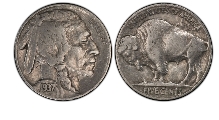
“It just seems that a nickel that is 85 years old would be worth more than 50C?” Was a recent response from someone who contacted us about their 1937 Buffalo Nickel. They had gone on eBay and “saw one just like it” that was worth thousands of dollars. “So, how could this be?” {insert customer distrust here}. So, it goes like this…
A coin’s value is determined by roughly 2 things. How many are known (Population), and the particular coins condition (Grade). If only a few coins were made, or survived recycling, that makes them less likely to be available for purchase today. It does not mean they are easy, or difficult to find, just that they have been removed from day-to-day circulation because they are perceived to be more valuable than new coins. The 1937 Buffalo Nickel above is a great example of this. Anyone that is lucky enough to find one in change would automatically want to keep it instead of spending it. I mean, just think of the stories it could tell if it could talk? But the thing here is that they made 75 Million of these babies. Now I don’t know anyone that literally throws money away, so at worst it winds up living in a jar or drawer somewhere up until right before you get it. I remember I had a batch of a few Cents once that were heavily stuck together with something nasty, and how hard it as for me just to throw away that 12 Cent bagel of crud. I could not help but feel like I had some patriotic duty to free those coins from their ooey-gooey sarcophagus, and it took energy to throw the mess away. Point is, it takes a lot to get us to throw money away, and that means it sticks around for a long time.
The other part of this equation is how nice the coin is. Coins are graded on a 70 Point Scale. 1 being poor and 70 being perfect. An uncirculated coin, as defined as a coin that has no break in original mint luster, are from grades 60 to 70. Anything below that (1-59) is circulated. Now if that 1937 Buffalo Nickel still looked like the day it was made, (Maybe your great-grandfather received a brand new roll at the bank in 1937 and put it away) and had never been cleaned or circulated, it could be worth $50. But you cannot compare that to a scratched and well-worn one you found in some dark corner somewhere.
So no one wants you to send us a photo of Grandpas roll of untouched nickels from 1937 more than us, but that old, well used, and common one you sent us a photo of? That’s still just worth 50C. Which is not bad, I wish all my investments did that good. If they did, I would not have to have wasted all these brain cycles learning which nickels were worth more than others right?
